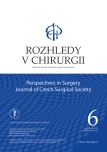Hand-assisted laparoscopic nephrectomy in morbidly obese patients
Authors:
J. Pacovsky 1,2; P. Hušek 1,2; J. Špaček 1,2; V. Giblo 1; M. Broďák 1,2
Authors‘ workplace:
Urologická klinika Fakultní nemocnice Hradec Králové
1; Lékařská fakulta v Hradci Králové, Univerzita Karlova
2
Published in:
Rozhl. Chir., 2020, roč. 99, č. 6, s. 271-276.
Category:
Original articles
doi:
https://doi.org/10.33699/PIS.2020.99.6.271–276
Overview
Introduction: Prevalence of obesity is 30 % in the Czech Republic and is expected to increase further in the future. This disease complicates surgical procedures but also the postoperative period. The aim of our paper is to present the surgical technique called hand-assisted laparoscopic nephrectomy (HALS), used in surgical management of kidney cancer in morbid obese patients with BMI >40 kg/m2.
Methods: The basic cohort of seven patients with BMI >40 undergoing HALS nephrectomy was retrospectively evaluated. Demographic data were analyzed (age, gender, body weight, height, BMI and comorbidities). The perioperative course (surgery time, blood loss, ICU time, hospital stay and early complications), tumor characteristics (histology, TNM classification, tumor size, removed kidney size) and postoperative follow-up were evaluated.
Results: The patient age was 38−67 years; the cohort included 2 females and 5 males, the body weight was 117−155 kg and the BMI was 40.3−501 kg/m2. Surgery time was 73−98 minutes, blood loss was 20−450 ml, and hospital stay was 5−7 days; incisional hernia occurred in one patient. Kidney cancer was confirmed in all cases, 48–110 mm in diameter, and the largest removed specimen size was 210×140×130 mm. One patient died just 9 months after the surgery because of metastatic disease; the tumor-free period in the other patients currently varies between 1 and 5 years.
Conclusion: HALS nephrectomy seems to be a suitable and safe surgical technique in complicated patients like these morbid obese patients. HALS nephrectomy provides acceptable surgical and oncological results.
Keywords:
Morbid obesity – nephrectomy − HALS
Sources
- www.cls.cz/dokumenty2/postupy/t069.rtf
- Rosen DC, Kannappan M, Kim Y, et al. The impact of obesity in patients undergoing robotic partial nephrectomy. J Endourol. 2019;33(6):431–437. doi:10.1089/end.2019.0018.
- Zhai T, Zhang B, Qu Z, et al. Elevated visceral obesity quantified by CT is associated with adverse postoperative outcome of laparoscopic radical nephrectomy for renal clear cell carcinoma patients. Int Urol Nephrol. 2018;50(5):845–850. doi:10.1007/s11255-018-1858-1.
- Sperling CD, Xia L, Berger IB, et al. Obesity and 30-day outcomes following minimally invasive nephrectomy. Urology 2018;121 : 104−111. doi:10.1016/j.urology.2018.08.002.
- Barlas IS, Aydogdu I, Sinangil A, et al. Hand-assisted nephrectomy predisposes incisional herniation in obese living donors. Transplant Proc. 2019;51(7):2210−2214. doi:10.1016/j.transproceed.2019.02.042.
- Khalil MI, Ubeda J, Soehner T, et al. Contemporary perioperative morbidity and mortality rates of minimally invasive vs open partial nephrectomy in obese patients with kidney cancer. J Endourol. 2019;33(11):920−927. doi:10.1089/end.2019.0310.
- Marchand C, Renard Y, Avisse C, et al. Symptomatic lumbar incisional hernia after open nephrectomy: What are the risk factors? Prog Urol. 2016;26(5):304−309. doi:10.1016/j.purol.2016.02.011.
- Morimoto Y, Takahashi H, Fujii M, et al. Visceral obesity is a preoperative risk factor for postoperative ileus after surgery for colorectal cancer: Single-institution retrospective analysis. Ann Gastroenterol Surg. 2019;3(6):657−666. doi:10.1002/ags3.12291.
- Cobb WS, Carbonell AM, Snipes GM, et al. Incisional hernia risk after hand-assisted laparoscopic surgery. Am Surg. 2012;78(8):864−869.
- Chiappetta S, Jamadar P, Stier C, et al. The role of C-reactive protein after surgery for obesity and metabolic disorders. Surg Obes Relat Dis. 2019. pii: S1550-7289(19)31042-1. doi:10.1016/j.soard.2019.10.007.
- Kawakita T, Iqbal SN, Overcash RT. Negative pressure wound therapy system in extremely obese women after cesarean delivery compared with standard dressing. J Matern Fetal Neonatal Med. 2019;5 : 1−5. doi:10.1080/14767058.2019.1611774.
- George AK, Rothwax JT, Herati AS, et al. Perioperative outcomes of laparoscopic partial nephrectomy stratified by body mass index. J Endourol. 2015;29(9):1011−1017. doi:10.1089/end.2014.0725.
- Brown JA. Minimally invasive partial nephrectomy feasible in morbidly obese? Can J Urol. 2014;21(1):7150.
- Reynolds C, Hannon M, Lehman K, et al. An obese body habitus does not preclude a minimally invasive partial nephrectomy. Can J Urol. 2014 Feb;21(1):7145−7149.
- Kaban GK, Czerniach DR, Litwin DE, et al. Hand-assisted laparoscopic surgery. Surg Technol Int. 2003;11 : 63−70.
- Siddiqui J, Young CJ. Thirteen-year experience with hand-assisted laparoscopic surgery in colorectal patients. ANZ J Surg. 2020;90(1−2):113−118. doi: 10.1111/ans.15578.
- Vávra P, El Gendi A, Papaevangelou A, et al. New treatment approach in liver metastates: hand-assisted laparoscopic radiofrequency liver resection. Rozhl Chir. 2007;86(10):554−557.
- Dostalík J, Martínek L, Vávra P, et al. Hand-assisted laparoscopic surgery of the colorectum. Rozhl Chir. 2002;81(11):560−563.
- Krska Z, Pesková M. Manually-assisted laparoscopic surgery. Rozhl Chir. 2000;79(6):225−227.
- Pacovský J, Navrátil P, Baker Kh, et al. Transplantace ledvin od žijících dárců. Urolog pro praxi 2004;3 : 101−104.
- Pacovský J, Navrátil P, Broďák M. Odběr ledviny k transplantaci od žijícího dárce. Urolog pro praxi 2006;1 : 15−18.
- Adam E, Golfier F, Lunel Potencier A, et al. Laparoscopic nephrectomy with vaginal extraction in obese or overweight patients: the end of wound complications? Prog Urol. 2013;23(7):444−449. doi:10.1016/j.purol.2013.03.001.
Labels
Surgery Orthopaedics Trauma surgeryArticle was published in
Perspectives in Surgery

2020 Issue 6
- Metamizole at a Glance and in Practice – Effective Non-Opioid Analgesic for All Ages
- Possibilities of Using Metamizole in the Treatment of Acute Primary Headaches
- Metamizole in perioperative treatment in children under 14 years – results of a questionnaire survey from practice
Most read in this issue
- Laparoscopic inguinal hernia repair in children via PIRS (percutaneous internal ring suturing)
- Endoscopic pilonidal sinus treatment (E.P.Si.T.) – first experiences and results
- Zenker’s diverticulum – effectiveness of endoscopic therapy
- Update and review of diagnosing functional anorectal disorders – standardized protocol for high-resolution anorectal manometry and the London classification
